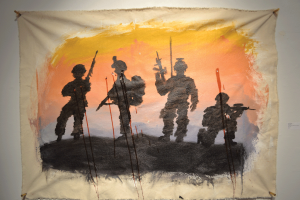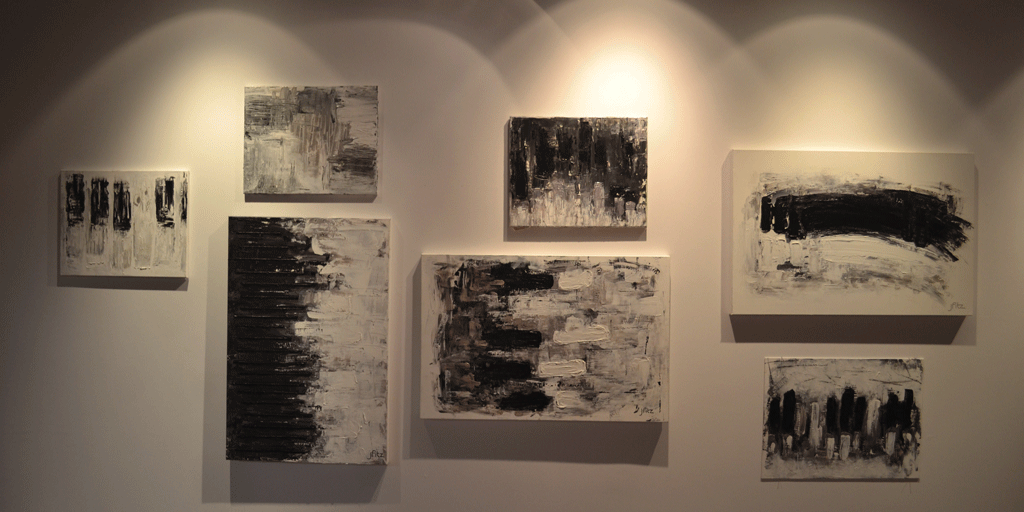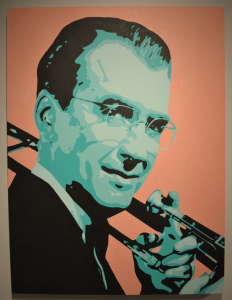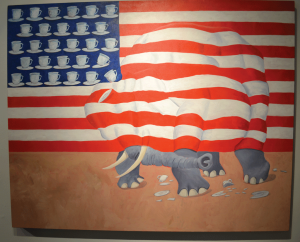By Valerie Franklin (The Cascade) – Email
Print Edition: September 10, 2014

UFV’s latest art exhibition, Find What Works, showcased how the artists did just that — and how it proved to be a transformative experience for each of them.
On September 5 the gallery space in B136 was filled with students, supporters, and art-lovers celebrating six directed studies art students, each of whom has spent the last several months exploring new painting techniques and honing their unique styles.
“‘Find what works.’ It’s a truism,” said Chris Friesen, the instructor who supervised these students. “Everything has something that’s outside the artist’s control.” None of the students’ first attempts or ideas ended up exactly as they originally expected; each went through a series of evolutions before the final paintings were ready to be unveiled.
“For me, this project was about experimenting and perfecting,” said student Ryan Cadarette, who painted a series of portraits of Duke Ellington, Glenn Miller, and George Gershwin based on classic photographs of the musicians. Cadarette painstakingly hand-drew each, then airbrushed them and painted them with acrylics. For him, refining his painting technique was a process of discovery.
“I had never used an airbrush before,” he explained. At first he experimented with spraypaint and stencils, but found the lines too harsh. “I found that airbrushing had a much softer effect,” he said. “I also found that I could use cloth instead of stencils to get rid of the hard edges.”
The result is photo-perfect – but instead of black and white like the photographs they’re based on, the paintings are executed in bright shades of candy-coloured paint.
“The idea is rooted in synaesthesia,” Cadarette explained. For a synaesthetic person, emotions, sounds, textures, and colours are all inextricably associated. As Cadarette listened to the music of the old jazz masters, he chose colours associated with the moods that their music put him in.
“I hope that you’ll be able to hear and feel the music when you look at my paintings,” he said.
Making music on canvas
The work of Cadarette’s fellow artist Janelle Fitz, a lifelong pianist, shares a similarly musical motif. Her elegant, abstract paintings feature thickly textured stripes of black and white, evoking images of piano keys and musical staves.
“Music has always been a big part of my life,” Fitz said. “I have some family members who were also involved with instruments, and music brought us closer together.”
Fitz described her painting style as being generally more representational; this project was her first attempt at expressing the qualities of an abstract concept like music through a visual form. The result is fluid and organic.
“I wanted to represent the energy and movement and beauty that music can evoke,” she said.
As Fitz refined this new, abstract style of painting over the months of the directed study, her confidence grew.
“Chris had me start off on 16-inch canvases,” she said. “Then I moved up to 2×3 feet. They’re displayed in the other gallery [in C building]. You can look at those and get an idea of how my process developed.” Her final pieces were painted on canvases measuring 3×4 feet and 5×2.5 respectively.
Masking the ordinary
Artist Jeff Rasmussen produced a series of colourful, kaleidoscopic paintings.
“For me, I’m a sculptor,” he stated. “I used to think that I was just a sculptor. But then I started painting, and realized that these are paintings informed by sculpture.”
His previous paintings also involved layering one colour on another, but there’s much more subtlety and variation in his new series: deep, monochromatic backgrounds slashed with strong lines of bright, up-front colour like searchlights across a sky. The shading of the paintings gives them exceptional depth and movement, as do the unusual textures of the manmade objects he airbrushes over, which include chains, fencing, mesh, and milk lids.
“I wanted people to think about the things we use in our everyday life and how they affect us,” Rasmussen said.
His process of repeatedly masking the canvas with objects and airbrushing over them creates an illusion of three-dimensional depth, like staring into a psychedelic cavern. It’s both geometric and organic at once.
“When it’s time to strip [off the layers of stencils], it’s like Christmas. Like an advent calendar. That’s what I should have called these, advent paintings,” Rasmussen said. “When you peel it off, you don’t know what you’re going to get.”
Like the other painters, Rasmussen underwent a psychological shift throughout this project. For him, it was learning to let go.
“I’m fussy. That’s a nice word for it,” he said, grinning. “Normally my paintings are very controlled, very photogenic. This explores a side of me that I wouldn’t have discovered if I hadn’t gone to this school, if I hadn’t been pushed.”
Drawing on modern politics
For student Scott Gordon, an art instructor himself, the process of discovery was less about honing his physical painting technique and more about learning to channel his political ideology into art. His paintings are Banksy-like in their simple but powerful statements on issues like gun control, healthcare, and economics. An American flag motif binds this series of paintings together; Gordon is Canadian, but is fascinated by the extremist tendencies of modern American politics.
“I don’t tend to use political themes, so this was very different for me,” he explained. “I just started playing with the idea of a flag and it began to flow.”
His piece “Rights of the Many or the Few?” shows the Second Amendment scrawled on the toe tag of a corpse, the outline of which is visible under an American flag. The stars on the flag have been replaced by Glocks, which, Gordon explained, are one of the most popular types of guns in the US, as well as being among the easiest to use.
“Rights of the Many or the Few” is particularly inspired by the Sandy Hook elementary school shooting of 2012.
“Being a teacher myself, I found it really horrific,” Gordon said. He was particularly alarmed that although there was an outcry for stronger gun control in the wake of the shooting, there was also a vocal movement to arm teachers with their own guns.
Another of Gordon’s pieces depicts an elephant, a symbol of the Republican Party, stumbling through an American flag and smashing teacups under its feet, representing how the Tea Party “acts like a bull in a china shop.”
Other hot topics his paintings address include the decision to evacuate Americans infected with Ebola back to the USA, and the Chinese control of world wealth.
But he didn’t set out to create any of these at the beginning of the course.
“What you see on the wall is not what I started with,” he said. “I had different plans, but I stopped having fun with those halfway through and threw them out.”
Among the most striking works in the gallery is the work of avid horseback rider Christine Homfeld, who created a series of paintings focusing on her black horse. But Homfeld, too, found her artwork going in an unexpected direction when she broke her clavicle and was unable to ride while she healed.
“Though some would see this as a disaster, I reconstructed it into an opportunity for enlightenment,” she wrote in her artist’s statement. She decided to explore the bond she shares with her horse through painting detailed studies of her.
“We think that by speaking louder and more forcefully, we can get animals to do what we want,” she said. But, she mused, a subtler and more nuanced approach is what will succeed. Homfeld’s gentle approach can be seen in the details of “Braviarre I”; the same patience that it takes to build a relationship with a horse is reflected in her careful, tender brushwork.
The gritty aesthetics of turmoil
The work of Kyle Huntley, a member of the Canadian Reserves, reflects his military background. His intense, fiery paintings centre on the representation of post-traumatic stress disorder, which, he points out, is an emerging epidemic among Canadian veterans.
“Many of my personal friends are suffering from it,” he says. “I’ve never been to combat, so I’m not affected directly.”
The subjects of his work are fellow soldiers caught in what Huntley calls these men’s breaking points: “what pushed them into turmoil, a tempest in their own minds.
“These are all people that I know. These are all emotionally charged moments,” he said.
Although Huntley said that he prefers a cleaner, monochromatic look in his usual work, in order to create these paintings, he abandoned his usual military precision and allowed himself to experiment freely. If the paintbrush didn’t go where he expected it to, he didn’t consider it a mistake. Even the canvas he painted on is unstretched and rough around the edges, adding to the intense, gritty aesthetic. As a finishing touch the painting was shot with a soldier’s gun, leaving a real bullet hole in the canvas which was then smeared with “blood” like a wound.
“In this,” Huntley said, “even just looking at them, you feel warm, you feel hot. You feel how they would have felt. The dirt, the grime …”
Unexpected directions
Friesen explained that while he’s worked with these students in classroom settings before, he was pleased to have a chance to coach them one-on-one through their artistic development — through uncharted territory and unexpected inspiration.
“That’s where the exhibition title came from,” he said with a smile. “We found what works.”



